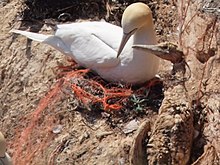Ghost network



A ghost net is a fishing net that was lost during fishing (e.g. in a storm, in an emergency, with net hookers) or was deliberately disposed of in the sea and has since been floating around there or caught on the seabed. These can be smaller nets from coastal gillnet fishing or trap fishing , but also large trawl nets or drift nets that are used in deep-sea fishing . In addition to the actual nets, the associated lines, otter boards and other parts are lost and can then drift in the sea for decades.
Environmental impact
Unmarked fishing nets floating in the sea pose a danger to fish, marine mammals, birds and other animals that get caught and perish there. The nets, which are usually made of plastic , can also contain toxic chemicals such as B. Release plasticizers . When rolling over the sea bed, in the swell (mechanical abrasion) and under the influence of UV ( embrittlement ), the nets break down into microparticles ( microplastics ), which also find their way into the food chain: almost ten percent of the waste (especially tear-resistant polymers ) in the oceans consists of ghost nets. According to the latest studies, the share of ghost nets in plastic waste in the sea is between 30 and 50% worldwide. According to a 2016 study by the Food and Agriculture Organization of the United Nations FAO, around 1,250 kilometers of fishing nets per year end up in the European seas as ghost nets; worldwide, fishing is the cause of more than a million tons of plastic waste in the oceans .
At present, various working groups are concerned with salvaging the nets and investigating whether such abandoned nets might not also offer a chance for the environment by serving as a habitat for animals and plants.
Archaeological finds
Often, trawls get lost on contact with wrecks, get tangled up in the remains of the ship and have to be abandoned. Historical wrecks can be damaged as a result, superstructures torn down when trying to rescue the nets and can thus become a problem for underwater archeology . Most of the time, such net hook positions are noted and avoided by fishermen, as they pose a risk of losing further fishing nets. But drifting nets can also get caught in wrecks, burden them with increased flow resistance or contribute to scouring .
Database and survey
As part of the third-party funded project “Ghost nets - Trap or Habitat?”, A reporting system or database for lost fishing gear should be implemented and scientifically implemented by the Scientific Diving Association Kiel and Terra Mare Excavation & Research with the involvement of sport and research divers as well as the fishing industry to be accompanied.
Elimination of networks
Various organizations have started to rescue ghost nets from the seas in recent years. For example, WWF Germany started a corresponding project in August 2013, in the course of which, among other things, nets were collected in the Baltic Sea. Most recently, a 1.5 ton trawl with gillnet remnants was recovered in the summer of 2016 . Private companies, such as Tönsmeier , sometimes also take part in the activities of nature and environmental protection organizations .
Web links
- Ghost nets: Ghost nets project
- WWF Germany: Ghost nets in the Baltic Sea
- Coastal Union Germany, EUCC-D: Photo collection on the subject of ghost nets
Individual evidence
- ^ Reply of the German Federal Government to a small inquiry
- ↑ Ghost nets - deadly danger on www.wwf.de , August 17, 2018
- ↑ Michael Weiland: Undead under water. Greenpeace , May 13, 2016, accessed July 14, 2016 .
- ↑ The project. In: Ghost Nets - Trap or Habitat? Scientific Diving Association, accessed July 14, 2016 .
- ↑ From practice. Terra Mare Excavation & Research, accessed July 14, 2016 .
- ↑ No more ghost nets: From the idea to recovery. WWF Germany, September 16, 2014, accessed on July 14, 2016 .
- ↑ WWF fishes for ghost nets. WWF Germany, accessed July 14, 2016 .
- ↑ Tönsmeier supports the WWF Ghost Networks project. In: WWF Germany. Retrieved July 14, 2016 .
